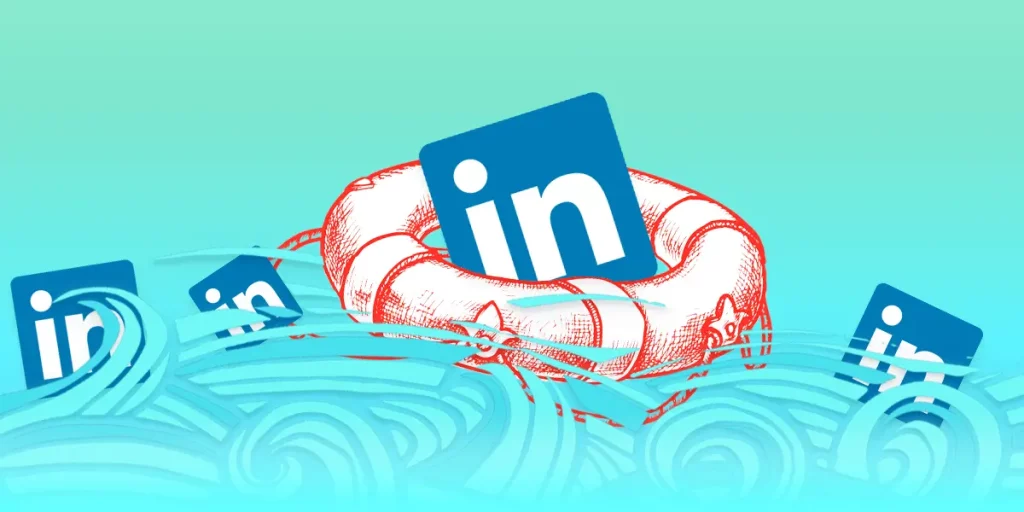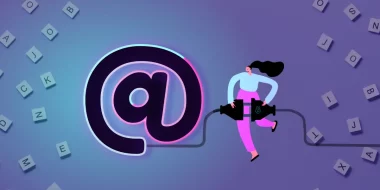A good LinkedIn summary resembles a strong handshake. It’s the first thing people read when they come across your profile. It’s also a great chance to leave a positive impression and stand out from the crowd. And we happened to find numerous impressive LinkedIn summary examples that do just that.
We'll show them to you in this article and will also tell you what a LinkedIn summary is, why you need it and how you can write your own.
In the end, it's a place where you can tell your story and portray yourself not just as an employee, but as a real, living person. And that's something recruiters love.
- What is a LinkedIn summary?
- How to write a LinkedIn summary
- 1. Use space wisely
- 2. Be authentic with first-person writing
- 3. Avoid buzzwords
- 4. Create an opening line for the summary preview
- 5. Show passion for what you do
- 6. Sprinkle your summary with some fun facts
- 7. Layer your life story
- 8. Use keywords from the skills section
- 9. Add a CTA (call-to-action)
- 10. Back up your words with examples
- 11. Incorporate testimonials
- 12. Proofread
What is a LinkedIn summary?
Generally speaking, a LinkedIn summary is the “about you” section on your LinkedIn profile. Usually, you can find it at the top of people's profiles. It's limited to 2,600 characters and it serves as an introduction to your professional, but possibly also to a personal story.
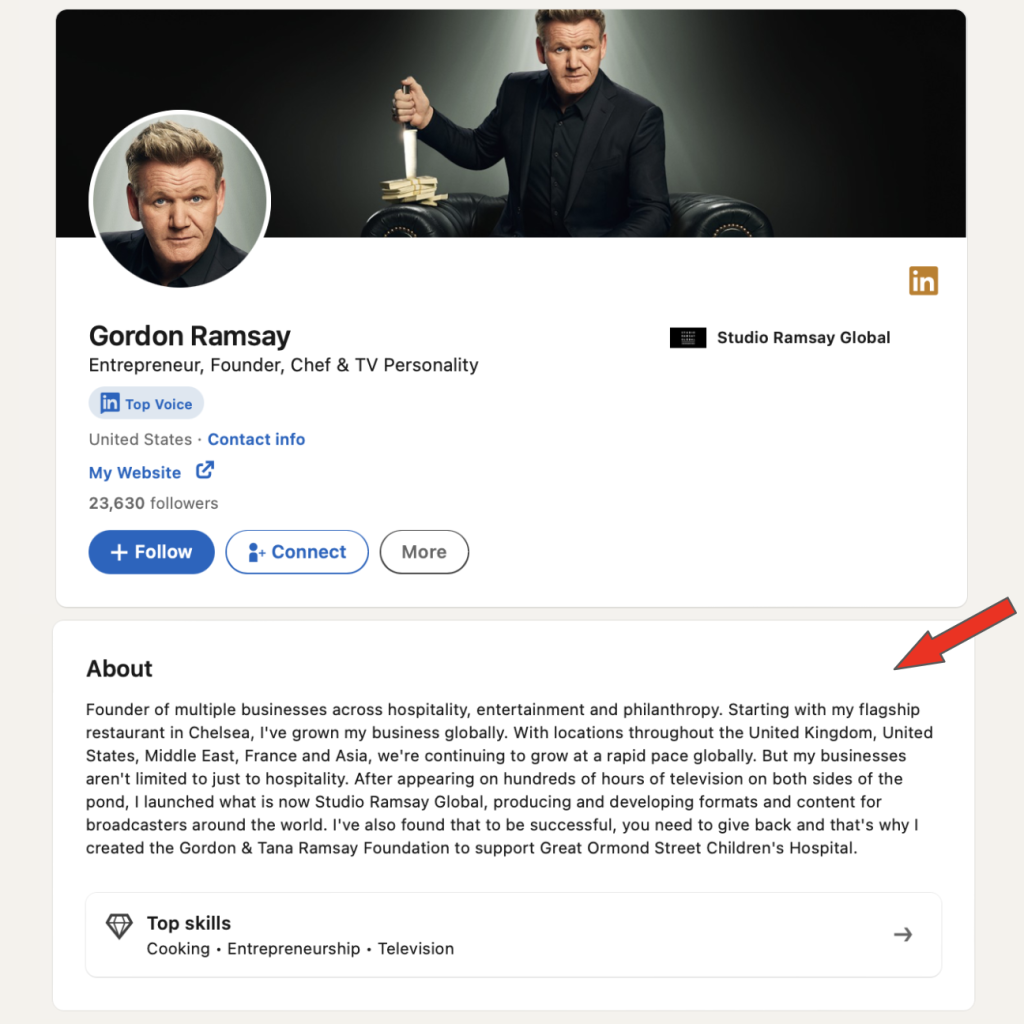
In a nutshell, it should tell:
- who you are,
- what are your key professional or educational accomplishments,
- skills,
- or even hobbies and personal traits.
Many LinkedIn users tend to think of their profile as a copy of their resume. But that couldn’t be further from the truth. Unlike a resume that’s always customized for a specific job opening, your LinkedIn profile (and a LinkedIn summary too) can be more universal and should speak to all the positions you might be considered for.
Although people often skip writing the summary section when they're creating their LinkedIn profiles, a LinkedIn summary has its important functions. Wherein, it can help you generate a lot of leads for jobs.
Note: A LinkedIn summary shouldn't be confused with a LinkedIn headline, which is the short piece of text that appears next to the user's name in search results (and on your profile under your name) and is limited to 220 characters. The headline should very briefly sum up who you are professionally. You can try LinkedIn Headline Generator to help you draft some ideas if you need a little help.
Why should you have a LinkedIn summary?
- It’s a unique opportunity to make a great first impression. This is especially important in the fast-paced hiring environment, where first impressions can make it or break it.
- If you have a strong LinkedIn profile, it sets you apart from the rest of the candidates.
- It creates an immediate sense of closeness. Your LinkedIn summary should leave people feeling like they’ve just met you for a friendly chat over a cup of coffee.
- You can show off your personality and biggest achievements right away.
How to add/edit a LinkedIn summary (About section)
- Click the Me icon at top of your LinkedIn homepage.
- Click View Profile.
- (If adding new section) Click Add profile section button under your name, then choose About you section.
- (If editing) Scroll down to the About section and click the Edit icon.
- In the Edit about pop-up window, fill out your information in the textbox.
- Click Save.
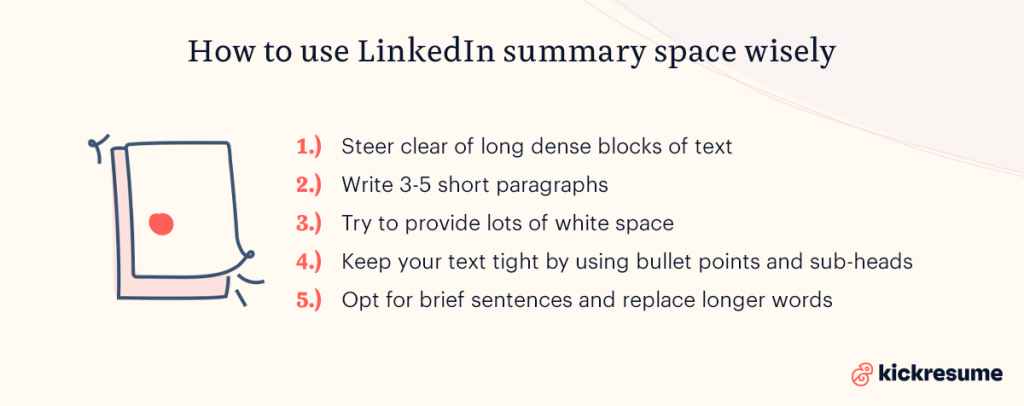
How to write a LinkedIn summary
If you want to have the best LinkedIn summary, see these 11 main principles which should be kept in mind when you'll be writing your LinkedIn summary:
- Use space wisely
Steer clear of long dense blocks of text. Ideally, write 3-5 short paragraphs.
- Be authentic with first-person writing
This will create an approachable and human impression.
- Avoid buzzwords
Words like "agile, innovative, passionate, motivated" are some of the most overused LinkedIn cliché buzzwords.
- Create an opening line for the summary preview
Unless the readers click to expand, they’ll see just a fragment of your summary that’s 220/92 (desktop/mobile) characters long.
- Show passion for what you do
Combine dry facts with stories and anecdotes to keep things human and engaging.
- Sprinkle it with some fun facts
Think of an unexpected, interesting fact about yourself and tie it to your professional career.
- Layer your life story
Start out by illustrating a situation that captures the essence of your role in an exciting way to keep your readers engaged.
- Use keywords from the skills section
Create a bulleted list of your keyword-specified specialties at the bottom of your LinkedIn summary.
- Add a CTA (call to action)
Wrap up your summary by including a call-to-action — like “message me with” or “email me at.”
- Back up your words with examples
Attach samples of your work by uploading them as media below your summary.
- Incorporate testimonials
A short quote from a previous employer, client, or colleague that highlights your skills, work ethic, or achievements adds a layer of social proof to your profile.
- Proofread
Keep drafting your summary until it’s perfect. And if you’re already satisfied, ask people you trust to give you some feedback.
Let's now talk about each principle in more detail. With each step, we'll also show you specific LinkedIn summary examples that were written and provided by real professionals on LinkedIn.
1. Use space wisely
The length of your LinkedIn summary is limited. And it’s so for a reason. Thanks to our shorter attention spans, we skim pages faster than ever. We replaced reading with clicking, scrolling a bit, and then moving on.
LinkedIn gives you only 2,600 characters to pull off a great overview of your professional life. So it’s not even worth trying to list everything you’ve ever done.
In fact, the best LinkedIn summaries are short. A too-wordy summary that uses all space that’s available is not going to win favor with anyone.
You should:
- Steer clear of long dense blocks of text
- Write 3-5 short paragraphs
- Try to provide lots of white space
- Keep your text tight by using bullet points and sub-heads that will facilitate reading
- Opt for brief sentences and replace longer words with their one or two-syllable synonyms
To see an example of optimum length, have a look at this LinkedIn summary of Jenny Foss:
LinkedIn summary example 1
2. Be authentic with first-person writing
Think about how you would speak to someone you've met at a conference. That’s the tone that you want to have in your LinkedIn summary — authentic, personal, but still professional.
In other words, pack it with personality and always write in the 1st person. This will create an approachable and human impression. Writing a summary about yourself in the 3rd person is a theatrical gimmick that would make you seem aloof, out of touch, and stuffy:
LinkedIn summary example 2
Now compare it to the following 1st person narrative:
LinkedIn summary example 3
3. Avoid buzzwords
Agile. Innovative. Passionate. Motivated. Creative. Expert. Strategic. Skilled.
Look at these words, don’t they sound too familiar?
Well, they might because these are some of the most overused LinkedIn cliché buzzwords. Their popularity made them lose their meaning and now they serve just as fluff. Try to avoid them.
If your summary happens to swell with overused phrases, it’s time to dust off your thesaurus. There are more than one million words in the English language, and that’s plenty to choose from.
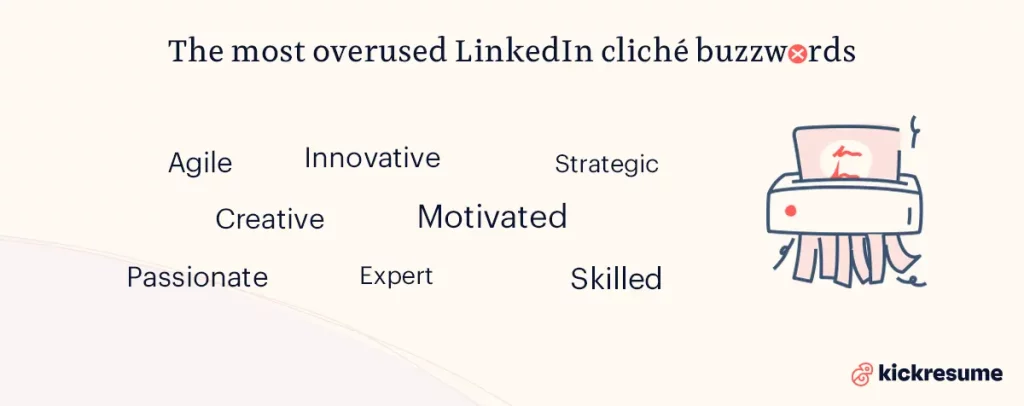
4. Create an opening line for the summary preview
It’s important to optimize your summary for previews. Unless the readers click to expand, they'll see just a fragment of your summary that's 220/92 (desktop/mobile) characters long.
The opening sentence doesn’t have to focus on what you’re currently doing. Whatever you choose, you must hook your reader right off the bat.
If you’re still in the dark, set a timer for 10 minutes and think about your opening line. You’re sure to come up with at least fifteen different openers to choose from:
LinkedIn summary example 4
LinkedIn summary example 5
LinkedIn summary example 6
LinkedIn summary example 7
5. Show passion for what you do
Alright. Now that you’ve got their attention, it’s time for a couple of paragraphs that will tell your story.
This section needs to show what makes you tick and demonstrate to everyone how excited you are about your work. Combine dry facts with stories and anecdotes to keep things human, engaging but also concrete:
LinkedIn summary example 8
LinkedIn summary example 9
LinkedIn summary example 10
LinkedIn summary example 11
Let people peek into your personal life. If you share some personal tidbits about yourself, people will gravitate toward you.
That's because readers feel more connected to a real person rather than to an unapproachable professional. So, when you write your LinkedIn summary, think of a few of the things you like to do in your free time and weave them into your summary just like people in the examples below:
LinkedIn summary example 12
LinkedIn summary example 13
6. Sprinkle your summary with some fun facts
Compared to a traditional resume, your LinkedIn profile is the place to tell your reader anything you want them to know.
Maybe you have expertise that's not covered by your qualifications. Or perhaps you’d like to branch out in a direction where you have no formal experience.
Feel free to put all of that into your LinkedIn summary. Think of an unexpected, interesting fact about yourself and tie it to your professional career. See the LinkedIn resume examples for inspiration:
LinkedIn summary example 14
LinkedIn summary example 15
LinkedIn summary example 16
7. Layer your life story
Storytelling can literally take your LinkedIn summary to another level.
It's science, believe it or not! Listening to stories boosts our levels of oxytocin and makes us emotionally engaged.
One of the ways of including a little tension in your story is to use a writing technique called “string of pearls.”
It will help you connect all pieces of your summary by creating an overlapping theme that will piece together persuasive details strand by strand. Start out by illustrating a situation that captures the essence of your role in an exciting way to keep your readers engaged.
Read the LinkedIn summary samples below to see what I mean:
LinkedIn summary example 17
LinkedIn summary example 18
8. Use keywords from the skills section
One of the ways to increase your LinkedIn profile views is to SEO-optimize your summary. This can be achieved by including keywords that highlight your top qualifications.
What is SEO? According to Michigan Technological University, Search engine optimization (SEO) is the practice of creating and optimizing relevant, authoritative content in a way that helps visitors (and search engine crawlers) find answers to their key questions.
To get more eyes on your profile, you need to be really specific — generic words like “sales” or “marketing” just won’t do. Create a bulleted list of your keyword-specified specialties at the bottom of your LinkedIn summary:
LinkedIn summary example 19
LinkedIn summary example 20
LinkedIn summary example 21
LinkedIn summary example 22
9. Add a CTA (call-to-action)
When you're closing your LinkedIn summary, think about what you want next. What action do you want your readers to take?
Are you looking for a new job or a complete career shift, do you want recruiters to message you with job opportunities? Do you want them to call you right away?
If the answer is yes, you have to offer them an easy way of contacting you. Wrap up your summary by including a call-to-action — like “message me with” or “email me at.”
Here are a few LinkedIn summary call-to-action examples:
LinkedIn summary example 23
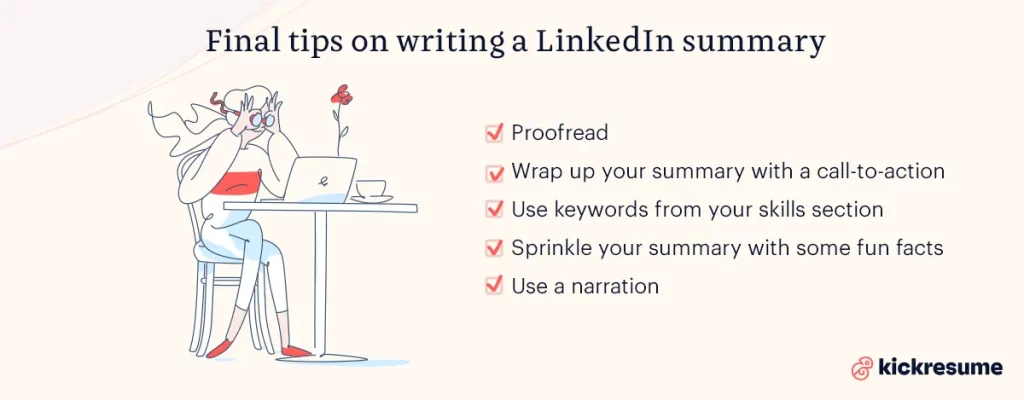
10. Back up your words with examples
Are you a prolific copywriter or a keen blogger? Don’t forget to attach samples of your work by uploading them as media below your summary.
This is the place to show off your recently finished articles, videos, slide decks, reports, or publications. Including a glimpse into your portfolio will make recruiters stay on your profile longer and see you really know what you’re talking about:
LinkedIn summary example 24
LinkedIn summary example 25
LinkedIn summary example 26
11. Incorporate testimonials
Including a brief testimonial within your LinkedIn summary can significantly boost your credibility and attractiveness to recruiters.
A short quote from a previous employer, client, or colleague that highlights your skills, work ethic, or achievements adds a layer of social proof to your profile.
When choosing a testimonial, select one that is relevant and speaks directly to the qualities that make you an excellent candidate for the types of roles you're interested in.
LinkedIn summary example 27
12. Proofread
Putting together your summary is no easy task. Prepare to wrestle with words, shuffle them around a bit, and remove those that don’t fit.
Keep drafting your summary until it’s perfect. And if you’re already satisfied, ask people you trust to give you some feedback. They can help you proofread your work and weed out any typos or grammatical errors you couldn’t spot yourself.
With these examples and tips to draw on, you should now have plenty of inspiration for your own LinkedIn summary.
Finally, don’t forget about other sections of your LinkedIn profile that deserve your attention. If you want to give your LinkedIn profile a total overhaul, check out our Ultimate LinkedIn Guide.
